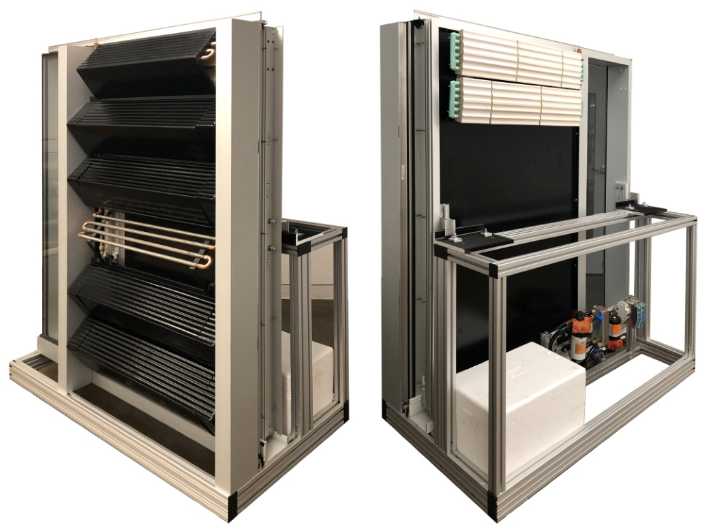A building's energy savings are usually focused on limiting the exchange of heat or cold through the facade. PhD candidate Jason Vollen turns the concept upside down: his ceramic facade system lets heat in and uses energy storage to make the heat useful for when its needed.
The Thermal Adaptive Ceramic Envelope does not only consist of ceramic panels; it also includes a large aluminum frame of about 2.5 meters that protrudes towards the inside of the facade. Hidden inside is a system with pipes and hoses in which fluids are circulated. The ceramic “radiator” plays the key role in the system. This provides heat exchange, in the same way as a car radiator. If the temperature outside is higher than inside, the radiation from the sun will heat up the fluid in the system. Heat is then released to heat the building. Inversely, when the interior temperature becomes too warm, the water transports the excess heat to the outer radiator. “The system works in the opposite way to a passive house,” says Vollen. “The energy passes through the facade, but we transform and slow down the energy release until the moment we need it.”

Vollen first tested his idea with computer models. Then he built three prototypes to demonstrate that it works. He used a simple pump and beer wort heat exchanger for the circulation of liquids. To prevent the building from heating up too quickly on a sunny day, the system contains a storage unit that can be filled with phase-changing material. This box of 20 x 40 centimeters converts heat into latent energy. When the building temperature drops below a certain threshold, the unit will release its energy again. In the demonstration project, this was easy to feel: the heat flowed from the unit into the office space. “In the demonstration model, it resulted in about 14 percent less heating energy consumption,” says Vollen. “Given the improvements that are possible, I think we can achieve 30 percent."
The system could function better by incorporating a dedicated heat collecting panel as well as an additional panel for heat delivery. The geometry of the ceramic elements could also be improved. The first prototype was built with cast tiles. In the second model the clay was pressed into a shape. The third prototype had ceramics made by extrusion. Vollen produced them with the help of specialists from Boston Valley Terra Cotta. “Extrusion makes it possible to produce tiles that can be connected in series,” explains Vollen. “That provides a much larger surface for collecting heat.” Another advantage of extrusion is that it enables large-scale production in a production line.
The energy storage functions require about one meter of space, the operating installation - pumps, pipes, manifolds, electricity - another one and a half meters. This leave the remainder of the facade for windows and heat collecting tiles.
Vollen succesfully tested his prototype in the New York City climate. The costs do not have to stand in the way of a market introduction, he thinks, because the various parts are cheaply available. As a prefabricated element, the unit can be moved to its place in the facade in one go.
The system is less energy efficient than a solar panel, but has the advantage of being able to operate on any side of a building. The major challenge is the integration in the facade, because this requires cooperation from various parties - from architect to facade builder to the mechanical, electricial and and plumbing trades.
Can the innovative facade system also be aesthetically successful? Vollen: “Yes! The system works great, that's why I think it's beautiful.”